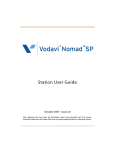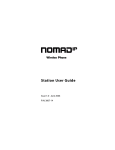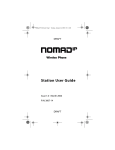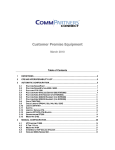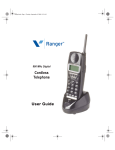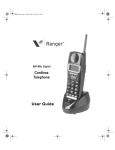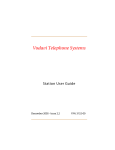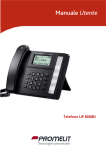Download Vodavi nomad IP User guide
Transcript
Station User Guide July 2005 - Issue 1.0 I Issue Release 1.0 7-05 Changes Initial Release LIFE SUPPORT APPLICATIONS POLICY VODAVI Technology, Inc. products are not authorized for and should not be used within Life Support applications. Life Support systems are equipment intended to support or sustain life and whose failure to perform when properly used in accordance with instructions provided can be reasonably expected to result in significant personal injury or death. VODAVI Technology, Inc. warranty is limited to replacement of defective components and does not cover injury to persons or property or other consequential damages. Copyright © 2005 VODAVI Technology, Inc. All Rights Reserved This material is copyrighted by VODAVI Technology, Inc. Any unauthorized reproductions, use or disclosure of this material, or any part thereof, is strictly prohibited and is a violation of the Copyright Laws of the United States (17 U.S.C. Section 101 et. seq.). VODAVI reserves the right to make changes in specifications at any time and without notice. The information furnished by VODAVI in this material is believed to be accurate and reliable, but is not warranted to be true in all cases. mlj/2005 Contents i Contents Introduction ..............................................................................................................1 Features............................................................................................................................................ 1 Installation and Setup..............................................................................................2 System Requirements ................................................................................................................. 2 Supported Operating Systems ................................................................................................ 2 Headset/Microphone Requirements..................................................................................... 3 Supported Protocols ................................................................................................................... 3 Nomad SP Connection ............................................................................................................... 3 Nomad SP Application Installation ........................................................................................ 4 Registration in a TeleniumIP System ..................................................................................... 7 Nomad SP Lock-key ............................................................................................................ 7 Registration Process ............................................................................................................ 7 Registration in an XTS IP/XTSc IP System............................................................................. 8 Remote Registration Error ................................................................................................. 8 Nomad SP Operation................................................................................................10 Overview.......................................................................................................................................... 10 Phone View ............................................................................................................................. 10 Keyset View............................................................................................................................. 11 Placing & Receiving Calls ........................................................................................................... 12 Placing a Call .......................................................................................................................... 12 Receiving a Call...................................................................................................................... 13 Using System Features ............................................................................................................... 14 Appointment Calendar............................................................................................................... 14 Keyset Folder Operation ............................................................................................................ 17 Flex Btn Folder....................................................................................................................... 18 Phone Book Folder............................................................................................................... 19 Call Log Folder....................................................................................................................... 22 Scheduled Dial Folder......................................................................................................... 24 Short Message Service in XTS IP / XTSc IP Systems .......................................................... 26 Short Message Service in TeleniumIP Systems.................................................................. 28 Nomad SP Tool Bar Operation.................................................................................30 Nomad SP View ............................................................................................................................. 30 E-Mail Operation ........................................................................................................................... 30 Record Operation ......................................................................................................................... 31 Exit ..................................................................................................................................................... 31 Nomad SP Station User Guide July 2005 ii Contents Menu Bar Operation .................................................................................................32 File Menu ......................................................................................................................................... 32 Phone Book............................................................................................................................. 32 Call Log .................................................................................................................................... 34 Program Menu............................................................................................................................... 34 E-Mail......................................................................................................................................... 34 Flex Data ................................................................................................................................. 35 Dialing Rules........................................................................................................................... 36 Differential Ring .................................................................................................................... 37 Tools Menu ..................................................................................................................................... 38 Log In ........................................................................................................................................ 38 Voice Record........................................................................................................................... 38 Connection Mode................................................................................................................. 40 Date Format............................................................................................................................ 41 Language................................................................................................................................. 41 Audio......................................................................................................................................... 42 Minimize .................................................................................................................................. 43 Help Menu....................................................................................................................................... 43 User Programming Differences ............................................................................................... 44 Nomad SP Station User Guide July 2005 Introduction 1 Introduction The Nomad SP is a PC-based application which links the operation of an on-screen multi-button telephone with other communications-related PC applications. Nomad SP is visualized on the desk-top and interfaced to the user via the mouse and keyboard. All the features of the traditional Vodavi IP multi-button keyset are available to the user. A Phone Book database with links to the user’s PIM (Personal Information Manager) provides pop-ups for incoming caller identification. Nomad SP users can employ the Phone Book to place calls as well as manage contact records. Other special functions available to Nomad SP users include: appointment scheduling, SMS support, e-mail, and call recording. Features The Nomad SP application includes the following feature/functions: Automatic database synchronization Display Mode (Phone/Keyset/Small, Calendar/Keypad) Phone Book calling Phone Book Management Database import/export (MS Outlook, GoldMine, ACT!, Excel) Scheduled Dial User call log User Short Message Service Voice Recording Connection Mode (Local/ Remote) E-mail with MS Outlook Flex button labels Incoming call pop-up window Help Nomad SP Station User Guide July 2005 2 Installation and Setup Installation and Setup Set-up of the Nomad SP is a three step process: 1. Connect the PC to the host Vodavi system. 2. Install the Nomad SP application on the user’s PC. 3. Complete registration of Nomad SP application to the Vodavi system. Completing the registration process may require assistance of the system administrator to adjust settings of the Vodavi system. For remote applications, the Vodavi system will require entry of the MAC address of the PC running the Nomad SP. Also, for remote users, the Nomad SP will require entry of the host Vodavi system IP address. Prior to installation, the PC and operating system should be verified for compatibility with the Nomad SP application. Ensure that the PC and OS (Operating System) comply with the minimum requirements as stated in the following two sections. System Requirements The minimum requirements for the Nomad SP are described below. Pentium 3 or compatible CPU 500 MHz clock speed or higher 128 Mbytes RAM 200 Mbytes of free hard-drive space 1024 x 768 resolution monitor CD-ROM drive Supported Operating Systems The Nomad SP application can run under one of two Microsoft Operating Systems: Microsoft Windows XP Microsoft Windows 2000 Nomad SP Station User Guide July 2005 Installation and Setup 3 Headset/Microphone Requirements To use the Nomad SP, a USB headset/microphone is required. The USB headset needs to be connected to the PC prior to launching the Nomad SP application, otherwise the heaset will not work properly. Supported Protocols G723.1 G.711 U-law Nomad SP Connection The PC running the Nomad SP application may be connected to the Vodavi system either as a local or remote device. The connection as a local device requires the Nomad SP to be connected to the same LAN as the host Vodavi system. When connecting as a remote device, the PC’s MAC address must be assigned as a Remote device in the Vodavi system for proper registration and operation. Refer to Remote Registration Error on page 8 for additional information on remote operation. Figure 1 provides a pictorial view of the connections to the Vodavi system. Local Nomad SP TeleniumIP or Remote Nomad SP Figure 1: Nomad SP Connections Nomad SP Station User Guide July 2005 4 Installation and Setup Nomad SP Application Installation When the Nomad SP CD-ROM is placed in the PC, an auto-execute install program will start. The InstallShield Wizard prepares the setup as shown in Figure 2. To abandon the installation, click Cancel. Figure 2: Nomad SP Setup In the next installation step, the default destination folder for the Nomad SP application can be modified using the Change button. The default directory for installation is “C:\Program Files\Nomad SP\”. It is possible to back-up one step in the install process or to cancel the installation. To continue the installation click the Next> button. Nomad SP Station User Guide July 2005 Installation and Setup 5 The Nomad SP Setup will show the Setup Status. Then the InstallShield Wizard Complete screen will appear. Click Finish to exit the wizard. Nomad SP Station User Guide July 2005 6 Installation and Setup Once the Nomad SP application has been installed, it is necessary to install WinPcap_3_0.exe. You must agree to the WinPcap license terms (Figure 3), to complete the Nomad SP installation. Figure 3: WinPcap License Window Nomad SP Station User Guide July 2005 Installation and Setup 7 Registration in a TeleniumIP System Nomad SP Lock-key Prior to registration of the Nomad SP with the host TeleniumIP system, the host TeleniumIP system will require installation of the Nomad SP software lock-key. This is accomplished by the Telenium system administrator under the system’s web Admin Maintenance window. The administrator should refer to the TeleniumIP Programming Manual for guidance. Registration Process To run the Nomad SP application: Click on the Nomad SP shortcut icon. The Nomad SP application will start and attempt to register with the host TeleniumIP system. LOCAL CONNECTION The initial registration, when locally connected, is automatic assuming the TeleniumIP system is set to allow registration. Refer to the TeleniumIP Installation Manual for the MFIM Registration Switch settings. Audio -- For a locally connected device, audio is from point to point over the LAN, NAT (Network Address Translation) is not supported, and IPSEC is not implemented. REMOTE CONNECTION When the Nomad SP is remotely connected the first time, registration will fail unless pre-registered in a local environment. When this occurs, the host TeleniumIP system IP address must be entered and the connection mode changed to remote in the Registration Error dialog box (Figure 4). Ensure the correct MAC "is In Use", is displayed in the message window. Registration may fail due to use of an improper IP address or MAC address. This can be corrected as outlined in Remote Registration Error on page 8. Audio -- For a remotely connected device, audio is handled through a system VoIP channel and remote NAT is supported. Nomad SP Station User Guide July 2005 8 Installation and Setup Registration in an XTS IP/XTSc IP System The Vodavi Outside Sales Department representatives will issue a registration code and information on how to register the product in an XTS IP/XTSc IP system. Remote Registration Error If a registration error occurs, the user will receive a Registration Error message and dialog box, Figure 4. In the dialog box, the user may enter the IP Address for the host Vodavi system, and configure the Nomad SP Connection mode (refer to page 40) and the appropriate MAC address for the PC. Figure 4: Registration Error Message & Dialog Box Nomad SP Station User Guide July 2005 Installation and Setup 9 To enter information in the dialog box, complete the following: System IP Address: 1. Select New IP Address box. 2. Enter new IP Address. Connection Mode: Select Local or Remote radio button. PC Network Interface Card: If the PC has multiple NICs, e.g., wired, wireless, VPN network support, etc., select the desired NIC from the drop down menu under In Use MAC. After changing characteristics in the message box it may be necessary to: 1. Select Retry to register. 2. Close the Nomad SP application. 3. Restart the application. Registration Error Messages that may be received include: No Response from System – there is no connection over the LAN to the host Vodavi system, the host IP address is incorrect, the Vodavi system is not set for local registration, the wrong NIC (MAC) is being used. Current Adapter NOT presently Available – the currently defined NIC is in use by another application, not connected, or has failed to properly connect to the LAN. Nomad SP Station User Guide July 2005 10 Nomad SP Operation Nomad SP Operation Overview Nomad SP interfaces with the user through the Nomad SP window (Figure 5). At the top of the Nomad SP window is the Menu bar; below the Menu bar is the Nomad SP tool bar. The two Nomad SP views are Phone View and Keyset View. Phone View The Phone view (Figure 5) emulates the basic Vodavi IP phone. An LCD area, keypad, and fixed feature buttons are arranged generally as with the traditional Vodavi IP phone. The fixed feature buttons give the user access to features and resources of the Vodavi system with the same displays as the LCD of an Vodavi IP multi-button phone. The user may dial with the mouse from the Keypad window or with numeric keys on the PC keyboard. Below the keypad, are the volume control up/down buttons and window selection buttons (Schedule and Keypad). The separate Speaker and Microphone icons are used to adjust the volume of the microphone or speaker independently with the adjustment slide bar to the right of the icons. Keypad Window Schedule Window Figure 5: Phone View Nomad SP Station User Guide July 2005 Nomad SP Operation 11 The Keypad window can be toggled to a Schedule window, (right illustration in Figure 5), which links to the user’s Outlook appointment scheduler. The Schedule view includes a scrolling display of daily events below the Schedule and allows access to the scheduler for managing appointments. At the bottom of the window, the user may access the Short Message Service (SMS) features of the Nomad SP to exchange short text messages with other users. Keyset View The Keyset view (Figure 6) adds the 4 Keyset folders to the right of the Phone view. The folders include Flex Button, Phone Book, Call Log and Scheduled Dial folders. The Flex Button folder emulates the multi-button function of the traditional 24-button Vodavi IP phone. The 24 Flex Buttons are fully programmable in the XTS IP/XTSc IP or TeleniumIP system database. Figure 6: Keyset View The user’s contact manager can be imported for the Phone Book folder, displaying information on contacts registered in the contact manager database. The Phone Book is used to place calls and send e-mails and can be searched, sorted and edited. The Phone Book database can be synchronized with an external source database each time the Nomad SP application is run. Nomad SP Station User Guide July 2005 12 Nomad SP Operation Also, changes made to the Phone Book database can be automatically exported to the external database to maintain synchronization. The Call Log folder maintains a database with a record of each call placed or received by the Nomad SP. The Call Log, if enabled, can be viewed, sorted and printed or can be disabled so no log records are generated. In the Scheduled Dial folder the user can input a phone number and a date & time to call the number; at the scheduled time the system will confirm and place the requested call. Placing & Receiving Calls Placing a Call The basic operation of placing a call for the Nomad SP is the same as the traditional Vodavi multi-button keyset. Dialing is accomplished by selecting digits from the Keypad window with the mouse or using numeric keys on the PC keyboard. For internal calls to other Vodavi IP system users: 1. Dial the station number or press a DSS/BLF Flex button. The digits will display in the LCD area. 2. Press the "Space" bar or select the Speaker button with the mouse to terminate the call. For calls external to the Vodavi system: 1. Select a Line button or dial the CO access code (generally "9"). 2. Dial the desired number. 3. Press the "Space" bar or select the Speaker button with the mouse to terminate the call. In addition to the basic calling operation, the user can also place calls by selecting records from the Phone Book folder (Phone Book on page 32) or Call Log folder (Call Log on page 34). The Nomad SP application must be the active application in order to place a call. Nomad SP Station User Guide July 2005 Nomad SP Operation 13 Receiving a Call When a call is received, the phone will "ring" and the Caller Information window will appear below the Nomad SP window (Figure 7). The window shows the caller ID delivered from the Vodavi system and the name associated from the Phone Book database. By selecting "More" from the window, the complete Phone Book record will be displayed. If a call is received while the Nomad SP is minimized, the Nomad SP and Caller Information window will pop-up to display the incoming call. Figure 7: Caller Information Window To answer the call: 1. Press the "Space" bar or select the Speaker button with the mouse. 2. Press the "Space" bar or select the Speaker button with the mouse to terminate the call. The Nomad SP application must be either the active application or minimized to the tray in order to receive a call. Nomad SP Station User Guide July 2005 14 Nomad SP Operation Using System Features The Nomad SP has complete access to all of the system features as well as the features available to the traditional Vodavi keysets, with the few exceptions based on the differences in the user platform (refer to User Programming Differences on page 44). The fixed feature keys operate in the same manner as the Vodavi IP phones except the mouse is used to select dial pad and feature buttons. Appointment Calendar The Nomad SP Calendar window displays a monthly calendar and a scrolling appointment display below the calendar of daily appointments derived from the user’s Outlook scheduler. By right-clicking the mouse over a date on the calendar, an Appointment Summary window is displayed over the Calendar window (Figure 8). Figure 8: Appointment Summary in Schedule Window Nomad SP Station User Guide July 2005 Nomad SP Operation 15 The Nomad SP Calendar window permits on-screen access to Outlook scheduler in two ways: Double-click on a date in the Calendar to add a new appointment. Right-click on the date with appointments already scheduled, then double-click on an appointment to edit. The Nomad SP will call the Outlook scheduler so that the user can add or modify an appointment in the Scheduler edit box (Figure 9). Figure 9: Outlook Scheduler Edit Window Enter a new or edit an existing appointment following Outlook instructions. When complete save and close the scheduler, this will save the file in the Outlook database and automatically update the Nomad SP Calendar database. Nomad SP Station User Guide July 2005 16 Nomad SP Operation When browsing the Calendar, the user may return to the current date display by clicking the Today button next to the month/year display in the Calendar window (Figure 10). Figure 10: Today Button in Calendar Window Nomad SP Station User Guide July 2005 Nomad SP Operation 17 Keyset Folder Operation The Keyset view adds the 4 Keyset folders including the Flex Btn (Flexible or Flex Button), Phone Book, Call Log and Schedule Dial folders to the right side of the Phone view (Figure 11). The separate folders are accessed by selecting the folder tab at the top of the Keyset folder window. Figure 11: Keyset View A Phone Book database can be opened from the File menu (File Menu on page 32). Once accessed from the File menu, operation in the folder is the same as described in the following sections. Nomad SP Station User Guide July 2005 18 Nomad SP Operation Flex Btn Folder The Flex Btn folder will display a 4 by 6 array of "Flex buttons" for a total of 24 (Figure 12). Each button includes a status icon, which displays the status of the CO Line or station associated with the button. The button also displays a designation from the system database, such as CO 001, SPD 001, etc. A descriptive label can be displayed in the bottom of the button. This label can be assigned by the Nomad SP user under the Program menu (refer to Flex Data on page 35). Figure 12: Flex Btn Folder Selecting a Flex button with the mouse will access a CO line, call a station, or activate a feature based on the function assigned to the Flex Button in the system database. Nomad SP Station User Guide July 2005 Nomad SP Operation 19 Phone Book Folder The Nomad SP maintains a Phone Book database (Figure 13), of the user’s contacts, both other internal system users and external contacts. The user can place calls and send e-mails to contacts selected from the database employing the search, sort, and record management tools in the Phone Book tool bar. When a record is added, edited, or deleted in the Phone Book, the Nomad SP can also update the original source database (refer to Phone Book on page 32). Figure 13: Phone Book with Call Window Nomad SP Station User Guide July 2005 20 Nomad SP Operation To call a number from the Phone Book: 1. Right click on the desired record (see search & sort below). 2. Click the icon from the Call window: Dial, Transfer, Conference, Scheduled Dial. -or1. Select the desired record. 2. Click the Dial icon from the Phone Book tool bar. -orDouble-click on the desired record or phone number field. To send an e-mail from the database: 1. Select the desired record(s). 2. Select the e-mail icon from the Phone Book tool bar, the Outlook e-mail program is called and loaded with the selected recipients’ e-mail address(es) filled in. 3. Type in subject, message, etc. and send the e-mail. To search the Phone Book database: Key in an alphanumeric string in the search box. To sort records in the Phone Book: Click on the header field at the top of the Phone Book to sort alphabetically/numerically. Click again for reverse order. To add or edit a record: 1. Select desired record for edit. 2. Click the add or edit icon to view the Contact Record form (Figure 14). 3. Key entries for available fields. Fields include: * Name, required field Multiple Phone Numbers E-mail address Company information Address Note Image (to remove image from contact record, right click on image to view Clear Image pop-up dialog box. Select Clear Image and OK.) Nomad SP Station User Guide July 2005 Nomad SP Operation 21 4. Select OK to save the record in the Phone Book and synchronize the source database. Figure 14: Contact Add/Edit Record Form To delete a record: 1. Select the desired record(s). 2. Click the delete icon on the Phone Book tool bar, the Confirmation window Figure 15 will appear. 3. Confirm delete by clicking OK to remove the record(s). Figure 15: Delete Confirmation Window Nomad SP Station User Guide July 2005 22 Nomad SP Operation Call Log Folder The Call Log folder (Figure 16) provides a log of all calls placed or received by the Nomad SP. If Call Log is enabled under the File menu, each call initiated or received will generate a record which will contain information on the call, as well as data derived from the Phone Book. Once the call is completed, a record is stored in the Call Log database. The record will contain the following fields: Date & Time: date and time of the call from the user’s PC Name: name of connected party from the Phone Book Phone: the called or calling party phone number Call Type: type of call, incoming/outgoing and answer/no answer Duration: duration the call was connected in hours, minutes and seconds Note: note entered by user Company: from the Phone Book Figure 16: Call Log Folder The tool bar at the top of the logs, allows the user to place a call and manage the Call Log database. To place a call from the Call Log: Double-click on the record to place the call. -or1. Select a record. 2. Click the Dial icon. Nomad SP will place a call to the phone number of record. Nomad SP Station User Guide July 2005 Nomad SP Operation 23 To store the Call Log: 1. Click on the Save icon. The Save As dialog box will appear. Select a folder, if other Nomad SP. 2. Enter the filename. 3. Select Save. The file is saved in an *.xls format for easy future access and all records in the Call Log folder are deleted. To add/edit a note or name field to a record: 1. Click the Edit icon. 2. Type the note or name in the edit dialog box. 3. Select OK to save in the Call Log. Although all the fields of the call record are shown in the Edit dialog box, only the Note and Name field can be edited and the Note field supports up to 250 characters. To add to the Phone book, Scheduled Dial: 1. Right-click on the desired record. 2. Click the Add to the Phone book, Scheduled Dial. Selecting the Delete icon will remove the selected record(s) and selecting the Del All icon will delete all records in the Call Log. In both cases, the user is asked to confirm the record deletion. Nomad SP Station User Guide July 2005 24 Nomad SP Operation Scheduled Dial Folder Scheduled Dialing permits the user to enter a phone number for dialing at a later scheduled time. When the scheduled time is reached, the Dial Confirmation window (Figure 17) will appear and must be confirmed by the user before dialing will begin. Figure 17: Dial Confirmation Window The Scheduled Dial folder (Figure 18) contains a list of the phone numbers and schedules entered by the user. The folder tool bar permits the user to manage the Scheduled dialing feature. Figure 18: Schedule Dial Folder Nomad SP Station User Guide July 2005 Nomad SP Operation 25 To add or edit a Schedule Dial: 1. Click the Add or Edit button on the Schedule Dial tool bar icon and the Schedule Dial dialog box appears (Figure 19). 2. Click the calendar icon to open a calendar window, then input the date. Date is a required entry. 3. Select the time (in 24-hour mode) from drop down selection menu. Time is a required entry. 4. Input or edit the telephone number. The telephone number is a required entry. 5. Input or edit name. 6. Select OK to save the schedule and number for later dialing. A date, time, and number must be entered. Figure 19: Schedule Dial Dialog Box To delete an entry from the Scheduled Dial folder: Select Delete to remove the record. The user will be asked to confirm the record deletion. Nomad SP Station User Guide July 2005 26 Nomad SP Operation Short Message Service in XTS IP / XTSc IP Systems Short Message Service (SMS) is typically provided in GSM mobile networks and is a service permitting users to share (send and receive) text messages with other users (refer to page 28 for information on SMS in TeleniumIP). A text message is comprised of an alphanumeric combination of up to 60 characters when used in XTS IP / XTSc IP systems. The Nomad SP can maintain an unlimited number of messages when used in XTS IP / XTSc IP systems. To send a text message to other users: 1. Click in lower portion of SMS window (Figure 20) and type message. Figure 20: SMS Window 2. Click on "Send To" in the SMS window and Figure 21 appears. Figure 21: SMS Recipient Window 3. Type the desired station number in the bottom left area of the window. To send to more than one station, type a comma between station numbers. Do not insert a space after the comma. 4. Click on "Send". The message is delivered. Nomad SP Station User Guide July 2005 Nomad SP Operation 27 When messages are received, a Msg button is displayed left of the "Send To" button. The number of messages received is shown in parens on this button. To review received SMS messages: 1. Click on the Msg button. The SMS Receive window will appear. 2. Click anywhere on the row of a message and the associated message will display in the bottom area of the window. 3. Click on a column’s heading to change the order of presentation, e.g., first-in, first-shown; first-in, last-shown. 4. Click on the "Refresh" button to update the SMS Receive Window display. Nomad SP Station User Guide July 2005 28 Nomad SP Operation 5. Use one of the following options to manage the mesages: Click on the "Delete" button to delete the selected message. -orClick on the "Reply" button to respond to a message. A window will appear that has the station number of the party that sent you the message and a "Send" button. 6. Type your message in the SMS window, then click on the "Send" button. Short Message Service in TeleniumIP Systems Short Message Service (SMS) is typically provided in GSM mobile networks and is a service permitting users to share (send and receive) text messages with other users (refer to page 26 for information on SMS in XTS IP and XTSc IP systems). A text message is comprised of an alphanumeric combination of up to 100 characters when used in TeleniumIP systems. When an SMS message is received, the Message Wait indication will activate and the user of the Nomad SP can review the received message. The Nomad SP can maintain up to 10 received messages in TeleniumIP systems, after which new messages are not stored. To send a text message to other users: 1. Click in lower portion of SMS window (Figure 22) and type message. Figure 22: SMS Window Nomad SP Station User Guide July 2005 Nomad SP Operation 29 2. Click on "Send To" in the SMS window and the following appears. 3. Select desired recipients by checking boxes; or by entering a range in the "From" and "To" boxes and then clicking on the "Set" button. 4. Click on the "Send" button. To review received SMS messages: 1. Click on the flashing MSG/CB button and the SMS Receive window will appear. A radio button displays for each received SMS message. 2. Click on the desired radio button to view it’s message contents. 3. Click the "Delete" button to remove the message. Nomad SP Station User Guide July 2005 30 Nomad SP Tool Bar Operation Nomad SP Tool Bar Operation Nomad SP View Nomad SP provides the user with a visual representation of a Phone on the desk-top. There are two views for the Nomad SP - Phone View and Keyset View. The Phone view emulates the appearance of the traditional Vodavi IP phone displaying an LCD area, keypad, and fixed feature buttons. The Keyset view adds the Keyset folders window. This window has 4 tabbed folders that the user can view: the Flex Btn folder with an array of 24 buttons, the Phone Book folder to show the user’s Phone book, the Call Log folder displays records for each call placed or received by the Nomad SP, and the Scheduled Dial folder, which permits the user to assign a phone number for dialing at a scheduled time. The view is controlled by the Phone/Keyset icon at the far left of the Nomad SP tool bar (Figure 23). The Nomad SP view will toggle between the Phone and Keyset views when the icon is clicked on. Figure 23: Phone/Keyset Tool Bar Icon E-Mail Operation With the Nomad SP, the user can access the Outlook e-mail application to send ad hoc e-mails. Access to the e-mail application is controlled by the e-Mail icon on the Nomad SP tool bar (Figure 24). Figure 24: Tool Bar E-Mail Icon Nomad SP will call the Outlook e-mail application when the e-Mail icon is selected. The e-mail application can also be called from the e-Mail item in the Program menu (refer to E-Mail on page 34). Nomad SP Station User Guide July 2005 Nomad SP Tool Bar Operation 31 Record Operation Nomad SP allows the user to record an active conversation to the PC’s hard disk. Recording is controlled using the Record icon on the Nomad SP tool bar (Figure 25). 1. Select the Record icon to start recording. 2. Select the icon again to stop recording. 3. When the recording is complete, Nomad SP will ask the user for a filename to use for storing the recording. Figure 25: Tool Bar Voice Record Icon Nomad SP generates a single record-start tone. You should notify other parties to any recording. Playback and management of recorded voice files is accomplished under the Tools menu Voice Record item (refer to Voice Record on page 38). Exit The user may terminate the Nomad SP application using the Exit icon on the tool bar (Figure 26). Figure 26: Tool Bar Exit Icon Nomad SP Station User Guide July 2005 32 Menu Bar Operation Menu Bar Operation File Menu The File menu gives access to the Phone Book and Call Log database management functions. Phone Book Selecting Phone Book from the File menu will present the Phone Book menu where the user may manage the Phone Book database (Figure 27). From this menu, the user may select to open a new or existing database, save a database, import or export a database or maintain synchronization with an external database. Once a Phone Book is opened, operation of the folder is the same as with the Keyset view (refer to Phone Book Folder on page 19). Figure 27: Phone Book Menu To open a new blank database for use with the Phone Book folder: 1. Select New from the menu. 2. Select a folder location. 3. Enter a filename. The user may select the database to employ for the Phone Book folder. Once selected, the selected database name will appear on the Phone Book tab and the database is used for Nomad SP Phone Book until a new selection is made by the user. Nomad SP Station User Guide July 2005 Menu Bar Operation 33 To open a selected database: 1. Select Open from the menu. 2. Select a database. The file format of the database must be consistent with the *.DB file format of the Nomad SP database; other file type selections will receive a warning message. Various contact manager applications employ different data formats. To permit use of common formats, Nomad SP allows the user to import databases from Outlook, GoldMine, ACT! or Excel applications. When imported, the database format is modified to match the Phone Book database and displayed in the Phone Book folder. To avoid potential conflicts between Nomad SP and GoldMine, always launch the GoldMine program after launching the Nomad SP. To import a database: 1. Select Import from the Phone Book menu. 2. Select the application type (Outlook, Gold Mine, ACT! or Excel). 3. Select the database. The user may save a copy of the Phone Book database as a back-up copy or for future use. To save a copy of a database: 1. Select Save As… from the Phone Book menu. 2. Select a folder, if different than the Nomad SP folder. 3. Select the filename. 4. Select Save. The Phone Book database can be exported for use in other applications including Outlook, Gold Mine, ACT! or Excel. To export a Phone Book database: 1. Select Export from the Phone Book menu. 2. Select the application type (Outlook, Gold Mine, ACT! or Excel). 3. Select the database. The Phone Book can be synchronized with an external Outlook, Gold Mine or ACT! database automatically. When synchronized, each time the Nomad SP is started it will use the external database as the Phone Book and will update the external database after any changes in the Phone Book. Nomad SP Station User Guide July 2005 34 Menu Bar Operation To enable automatic synchronization: 1. Select Sync DB from the Phone Book menu. 2. Select the application type (Outlook, Gold Mine, ACT! or Excel) 3. Select the database. Note that changes made directly to an external database are not effective in an active Nomad SP. Such changes require a restart of the Nomad SP application to update the active Phone Book database. Call Log Selecting Call Log from the File menu will display the Call Log menu (Figure 28). From the Call Log menu, the user may enable or disable the Call Log function. Figure 28: Call Log Menu Program Menu Figure 29: Program Menu E-Mail With the Nomad SP, the user can access the Outlook e-mail application to send ad hoc e-mails. Access to the e-mail application is provided by the e-Mail item in the Program menu, which, when select, will call the Outlook e-mail application. The e-mail application can also be called from the e-Mail icon on the Nomad SP tool bar (refer to E-Mail Operation on page 30) or from the Phone Book. Nomad SP Station User Guide July 2005 Menu Bar Operation 35 Flex Data In the Flex Btn folder, each button is displayed with a status icon and a designation provided to the Nomad SP by the Vodavi system (refer to Flex Btn Folder on page 18). For convenience, the user can enter a label that will be shown in the lower portion of the button. To assign Flex button labels: 1. Select the Flex Data item from the Program menu. The Flex Data window will appear (Figure 30). Figure 30: Flex Data Window 2. Select the desired Flex button (FLEX 1 to FLEX 24) label field. 3. Type in the desired label, up to 12 characters. 4. If you check the Left/Right of the Layout box, the new labels are aligned to the left/right side of the flex button. 5. Click OK. 6. When complete, click on the Close icon to return to the Nomad SP screen. The new labels will be shown in the Flex Btn folder. Nomad SP Station User Guide July 2005 36 Menu Bar Operation Dialing Rules When the user places an outside call from the Phone Book or Call Log folder, the Nomad SP must include certain dial codes to assure proper dialing through the Vodavi system. When a number is selected from either database, the system will determine the type of call and insert any CO Access Code, LD Access Code or International Access Code required for the host Vodavi system to properly establish the call. Codes are entered in the Dialing Rules dialog box (Figure 31) along with local codes for comparison. To enter codes: 1. Select Dialing Rules from the Program menu. 2. Enter the various codes. 3. Select Save. Figure 31: Dialing Rules Dialog Box Nomad SP Station User Guide July 2005 Menu Bar Operation 37 Differential Ring The Nomad SP can provide one of 4 different ring signals with separate assignments for internal and external calls. Each of the 4 ring signals is contained in a *.wav file. The user may select one of the 4 predefined *.wav files (ring1.wav, ring2.wav, ring3.wav, and ring4.wav) or may replace any of these files with a desired *.wav or *.mp3 file. Selecting Program > Differential Ring displays the Ring tone files window (Figure 32). To change a Ring tone file: 1. 2. 3. 4. Select the change icon next to file to be replaced. Select the desired *.wav or *.mp3 file from the PC’s file system. Select Apply. Close the Ring tone files window and the new file may be selected for use. Figure 32: Ring Tone Files Window To select a Ring Tone for use (In a TeleniumIP system): 1. 2. 3. 4. 5. Click the PGM fixed feature button. Dial 1 for Ring Tone Selection. Dial 1 for Intercom Ring or 2 for CO/IP ring. Dial desired Ring Tone (1-4). A short burst of the tone is generated. Press SAVE. To select a Ring Tone for use (In an XTS IP/XTSc IP system): The Ring 1 setting in Program > Differential Ring is the one that will be used for both Intercom Ring and for CO/IP Ring. Ring 2-4 options in Program > Differential Ring do not apply to XTS IP/XTSc IP systems. Nomad SP Station User Guide July 2005 38 Menu Bar Operation Tools Menu Various tools and applications are accessed by selecting the Tools Menu. Log In Nomad SP can retry to register with the System. Selecting Tools > Log In will display the Registration window. In this window, the user may enter the IP Address for the host XTS IP/XTSc IP or TeleniumIP, and configure the Nomad SP Connection mode and appropriate MAC for the PC. To enter information in the window, refer to Remote Registration Error on page 8. Voice Record Nomad SP permits recording of a conversation onto the PC’s hard drive. Recorded conversations can be reviewed after recording. In addition, a voice memo can be added to the recording and the recording with memo sent by e-mail as attached *.wav files. Selecting Tools > Voice Record displays the Record/Play selection menu. Selecting Record while in a conversation will activate the recording function, recording both sides of the Nomad SP conversation. Recording may also be activated from the Nomad SP tool bar icon (refer to Record Operation on page 31). Nomad SP Station User Guide July 2005 Menu Bar Operation 39 Nomad SP sends a single record-start tone. You should notify the other parties to any recording. Selecting Play will show a list of recorded files in the Playback window (Figure 33). The window includes playback controls for playing a selected file. The user may delete a file, record a comment, and/or e-mail the recording using the Playback window controls. Figure 33: Recorded Files & Playback Window & Controls Nomad SP Station User Guide July 2005 40 Menu Bar Operation Connection Mode Nomad SP can be registered to a TeleniumIP system in Local or Remote Mode. Nomad SP can be registered to an XTS IP/XTSc IP system in Remote Mode. In the Remote Mode, the Vodavi system allocates a VoIP channel to support the call. The VoIP channel implements NAT (Network Address Translation) compatibility and packet forwarding to internal appliances. Selecting Tools > Connection Mode, will display the Local/Remote selection window with the present mode checked. When either mode is selected, using the mouse, the Nomad SP will terminate and re-connect with the host Vodavi system to establish the selected connection mode. Nomad SP Station User Guide July 2005 Menu Bar Operation 41 Date Format The format used for the date display of the Phone Book, Call Log, and Scheduled Dial folders can be changed from day/month/year to month/day/ year. Selecting Tools > Date Format will display the format selection window with the present selection checked. Click the desired Date Format in the menu. The date display for the Nomad SP LCD area is controlled by the XTS IP/XTSc IP or TeleniumIP system and may be different from the selected Date Format in the Nomad SP. Language English is the default language. The Local Language option is reserved for future use. Selecting Tools > Language, will display the English/Local Language selection window with the present mode checked. Nomad SP Station User Guide July 2005 42 Menu Bar Operation Audio The Nomad SP can control the audio input/output device employed. The device for audio input and output is selected in the Audio Device Controls screen, figure as below. The audio output device (received audio) can be defined separately for voice and ring signals. Selecting the Audio device drop-down menu will display the device choices available. Nomad SP Station User Guide July 2005 Menu Bar Operation 43 Minimize When the Nomad SP application is executed, a tray icon is created (Figure 34). When the application is "minimized", the Nomad SP icon is moved to the system tray. In this way, the application does not clog the program tray. Figure 34: Nomad SP Desk-top Tray Icon To restore the Nomad SP: Click the tray icon. -or1. Right-click with the mouse pointer on the icon. 2. Select Show or Exit from the pop-up menu. Figure 35: Nomad SP Desk-top Tray Menu Help Menu The Nomad SP Help yields a wealth of information on the operation of the Nomad SP. To access the Help menu, select the Help item from the menu or press the "F1" key. Nomad SP Station User Guide July 2005 44 Menu Bar Operation User Programming Differences As previously noted, the Nomad SP operates in essentially the same manner as the traditional Vodavi IP phone. There are, however, several user programmable functions which are not supported due to differences in the platform, i.e., Nomad SP versus Vodavi IP phone. Also several functions that can be used in one system are not supported in another system, i.e., TeleniumIP versus XTS IP/XTSc IP (refer to the applicable XTS IP/XTSc IP or TeleniumIP User Guide for other feature operation descriptions). These differences are described in the following Table. Feature XTS IP/XTSc IP TeleniumIP Page Registration Code from Vodavi Inside Sales & flash programming Lock Code in web-based programming 7 Differential Ring One ring tone for CO/IP & ICM calls Different ring tones possible for CO/IP & ICM calls 37 OHVO Not supported Supported -- Background Music Not supported Supported -- Ring Tone Selection Feature code 695 is not supported; however, can use different wav file Supported 37 Pages Can make a page, but can’t receive Can make and receive pages -- PGM Button Function H-P-T button User programming -- ICM Button No current function Supported -- SAVE Button No current function Supported -- Audio Source Control N/A Sta PGM 6 is not supported -- Sta Answer Mode H-T-P function supported via PGM button Tone mode only; Sta PGM 13 is N/A -- Sta Ring Download N/A Sta PGM 15 is not supported -- Local/Remote Mode Remote mode is supported Both modes are supported -- Nomad SP Station User Guide July 2005
















































